To maintain your greywater system, start with monthly inspections of pipes, pumps, and drainage fields. Clean or replace filters every 3-6 months, and sanitize storage tanks regularly. Test water quality quarterly, monitoring key parameters like pH and turbidity. Address odor issues promptly by checking for clogs and ensuring proper aeration. Don't forget to winterize your system in colder climates by draining pipes and insulating components. Repair leaks and cracks as soon as you spot them, and consider upgrading older parts for improved efficiency. By following these steps, you'll keep your greywater system running smoothly. Dive deeper to uncover more expert tips and tricks.
Regular Inspection Schedule
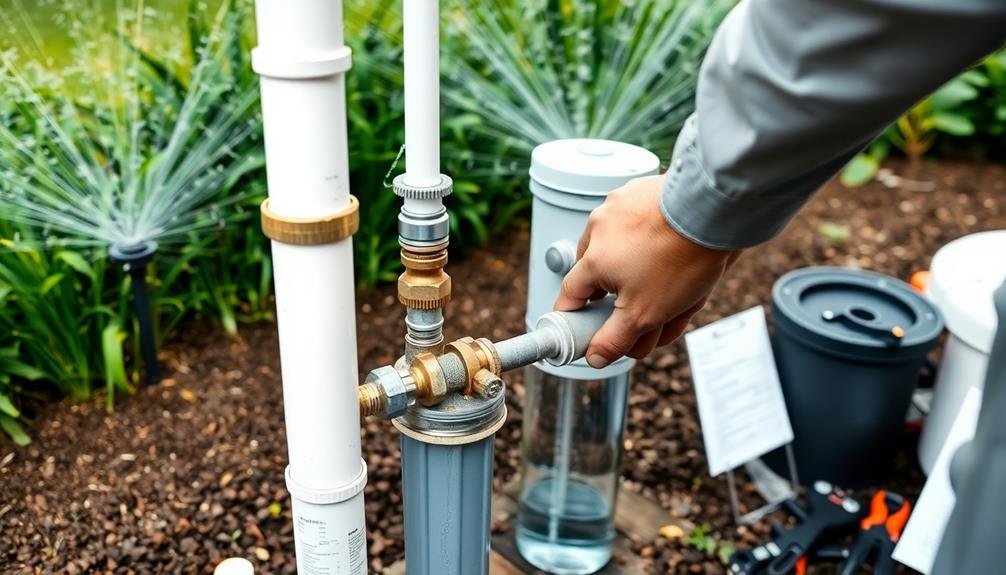
Establishing a regular inspection schedule is essential for maintaining your greywater system's efficiency and longevity. You'll need to check your system at least once a month to verify it's functioning properly.
Start by inspecting the collection pipes for any signs of leaks, clogs, or damage. Look for wet spots or unusual plant growth around buried pipes, which may indicate a leak.
Next, examine the filtration components. Clean or replace filters as needed, typically every 3-6 months depending on usage. Check the storage tank for sediment buildup and clean it annually.
Inspect pumps and valves for proper operation, lubricating moving parts if necessary.
Don't forget to assess the distribution system. Verify that irrigation lines are free from blockages and emitters are working correctly. Look for signs of overwatering or underwatering in your landscape.
Test the water quality periodically to ensure it meets safety standards for its intended use.
Keep a maintenance log to track inspections, repairs, and part replacements. This will help you identify patterns and anticipate future needs.
Filter Cleaning and Replacement
Serving as the heart of your greywater system, filters require regular cleaning and occasional replacement to maintain peak performance.
You'll need to clean your filters every 3-6 months, depending on usage and water quality. Start by shutting off the system and draining any excess water. Remove the filter housing and carefully extract the filter. Rinse it thoroughly with clean water, using a soft brush to remove stubborn debris. If you notice significant wear or damage, it's time for a replacement.
When replacing filters, confirm you choose the correct type and size for your system. Most greywater systems use a combination of filters, including:
- Mesh screens for large particles
- Sand filters for finer sediment
- Activated carbon filters for chemical removal
Keep spare filters on hand to avoid system downtime.
After cleaning or replacing, reassemble the filter housing, confirming proper sealing to prevent leaks. Before restarting the system, check for any loose connections or signs of wear in the surrounding components.
Regular filter maintenance not only improves water quality but also extends the life of your entire greywater system, saving you money and resources in the long run.
Pipe and Pump Maintenance
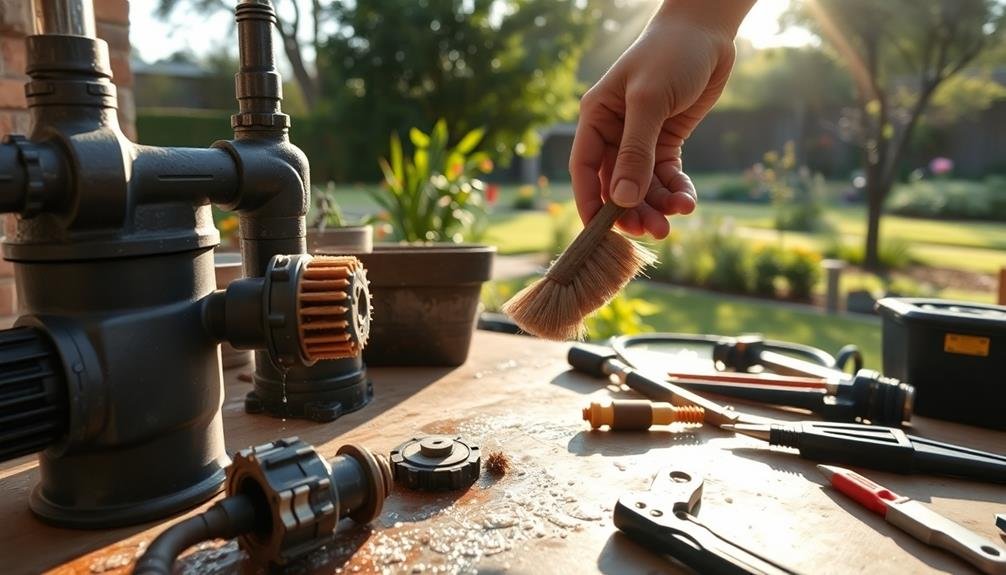
To keep your greywater system running smoothly, you'll need to stay on top of pipe and pump maintenance. Regularly inspect your pipes for leaks, clogs, or damage. Flush the pipes with clean water every few months to prevent buildup of soap scum and debris. If you notice slow drainage or unusual odors, it's time to clean your pipes thoroughly.
For pumps, check them monthly for proper operation. Listen for unusual noises or vibrations that might indicate wear or damage. Clean the pump's intake screen regularly to prevent blockages. Lubricate moving parts according to the manufacturer's instructions, typically every six months.
Inspect electrical connections and verify they're tight and free from corrosion. Replace worn seals or gaskets promptly to prevent leaks. If your pump has an impeller, check it annually for wear or damage and replace if necessary.
In colder climates, protect your pipes and pump from freezing by insulating them or using heat tape. Drain the system before winter if it won't be in use.
Storage Tank Sanitization
While maintaining pipes and pumps is important, keeping your storage tank clean is equally essential for a healthy greywater system. Regular sanitization prevents the buildup of harmful bacteria and guarantees the water remains safe for its intended use.
To sanitize your storage tank, you'll need to empty it completely and scrub the interior surfaces with a mild detergent solution. After cleaning, rinse the tank thoroughly and disinfect it using a chlorine solution.
Mix 1 cup of household bleach with 1 gallon of water for every 50 gallons of tank capacity. Fill the tank with this solution and let it sit for at least 12 hours. Afterward, drain the tank and rinse it well with clean water.
To maintain a sanitary storage tank between cleanings:
- Monitor water quality regularly, checking for odors or discoloration
- Install a filtration system to remove debris before water enters the tank
- Keep the tank covered to prevent contamination from external sources
Drainage Field Upkeep

In addition to tank maintenance, proper drainage field upkeep is essential for your greywater system's longevity and efficiency. Regularly inspect your drainage field for signs of saturation, odors, or slow draining. These issues can indicate problems that need immediate attention.
To maintain your drainage field:
- Avoid compacting the soil by limiting foot traffic and heavy equipment in the area.
- Keep trees and deep-rooted plants away from the field to prevent root intrusion.
- Divert surface water runoff away from the drainage area to prevent oversaturation.
- Monitor for any unusual plant growth or wet spots, which may signal system failure.
- Schedule professional inspections every 1-2 years to catch potential issues early.
Here's a quick reference guide for drainage field maintenance:
| Task | Frequency | Importance | DIY or Pro? | Tools Needed |
|---|---|---|---|---|
| Visual inspection | Monthly | High | DIY | None |
| Soil aeration | Annually | Medium | DIY | Garden fork |
| Root removal | As needed | High | Pro | Specialized equipment |
| Leveling | Every 2-3 years | Medium | DIY | Rake, soil |
| Professional check | Every 1-2 years | High | Pro | Various |
Water Quality Testing
To guarantee your greywater system operates safely, you'll need to implement a regular testing schedule.
You should check key parameters such as pH, turbidity, and bacterial levels at least quarterly.
These tests will help you identify potential issues early and maintain the overall effectiveness of your system.
Regular Testing Schedule
Maintaining a regular testing schedule for your greywater system is essential to confirm its safe and efficient operation. You should aim to test your system's water quality at least quarterly, with more frequent checks if you notice any changes in odor, color, or plant health.
Keep a log of your test results to track trends and identify potential issues early on. Your regular testing schedule should include:
- pH levels
- Dissolved oxygen content
- Turbidity (cloudiness)
Additionally, test for nutrients like nitrogen and phosphorus, as well as bacteria levels. You can purchase home testing kits or send samples to a laboratory for more thorough analysis.
If you're using the greywater for irrigation, pay special attention to salinity levels, as high salt content can harm plants.
Don't forget to inspect your system's components during each testing session. Check filters, pumps, and pipes for any signs of wear or blockages.
If you notice any abnormalities in your test results or system performance, consult a professional immediately. By maintaining a consistent testing schedule, you'll confirm your greywater system remains safe, effective, and compliant with local regulations.
Key Parameters to Check
What key parameters should you monitor when testing your greywater system's water quality? Focus on these essential indicators:
pH levels: Maintain a pH between 6.5 and 8.5 to guarantee ideal plant growth and prevent pipe corrosion. Test regularly and adjust if necessary.
Dissolved oxygen: Aim for at least 2 mg/L to support beneficial microorganisms and prevent foul odors. Low levels may indicate system overload or poor aeration.
Turbidity: Monitor water clarity, as high turbidity can clog irrigation systems and harm plants. Keep levels below 2 NTU for effective filtration.
Electrical conductivity: This measures salinity and dissolved solids. Keep it below 3 dS/m to prevent salt buildup in soil and plant damage.
Biological oxygen demand (BOD): A high BOD indicates excessive organic matter, potentially overwhelming your system. Maintain levels below 30 mg/L.
Fecal coliform: Check for these bacteria to guarantee proper disinfection. Levels should be below 200 CFU/100mL for safe irrigation use.
Total suspended solids (TSS): Keep TSS below 20 mg/L to prevent clogging and extend your system's lifespan.
Addressing Odor Issues

Unpleasant smells can be a telltale sign of issues in your greywater system. If you're noticing foul odors, it's essential to address them promptly to maintain system efficiency and prevent potential health hazards.
First, check for any clogs or blockages in your pipes and filters. These can cause water to stagnate, leading to bacterial growth and unpleasant smells. Clean or replace filters as needed, and consider using a drain snake to clear any stubborn blockages.
Next, verify your system is properly aerated. Lack of oxygen can lead to anaerobic conditions, which produce sulfurous odors. If you're using a constructed wetland or biofilter, make sure plants are healthy and not overgrown, as they play a significant role in oxygenation and filtration.
To further combat odors:
- Use natural, biodegradable soaps and detergents to reduce chemical buildup
- Regularly flush the system with clean water to prevent sediment accumulation
- Consider adding beneficial bacteria or enzymes to break down organic matter
If odors persist despite these measures, you may need to reassess your system's design or consult a professional for a thorough inspection and potential upgrades.
Winterizing Your Greywater System
To protect your greywater system during winter, focus on two key areas: draining pipes and insulating exposed components.
You'll need to fully empty all pipes to prevent freezing and potential damage.
Don't forget to wrap insulation around any above-ground parts of the system, including valves and filtration units, to safeguard against cold temperatures.
Draining Pipes Completely
When winter approaches, how can you protect your greywater system from freezing temperatures? One vital step is draining your pipes completely. This process guarantees that no water remains in the system, preventing potential damage from freezing and expansion.
To drain your pipes effectively, start by turning off the main water supply to your greywater system. Next, open all valves and faucets connected to the system, allowing water to flow out. Use a compressor to blow air through the pipes, pushing out any remaining water. Don't forget to drain outdoor components, such as irrigation lines and storage tanks.
For thorough pipe draining, follow these steps:
- Disconnect and drain all hoses and filters
- Remove and clean pump impellers
- Use a wet-dry vacuum to extract water from low points in the system
Pay special attention to areas prone to collecting water, such as U-bends and horizontal pipe sections.
Consider using pipe heating cables in particularly cold climates for added protection. After draining, leave valves open to prevent pressure buildup if any residual water freezes.
Insulating Exposed Components
After draining your pipes, the next key step in winterizing your greywater system is insulating exposed components. This process helps prevent freezing and damage during cold weather.
Start by identifying all exposed pipes, valves, and fittings in your greywater system, particularly those in unheated areas or outside.
Wrap these components with foam pipe insulation, ensuring a snug fit around pipes and joints. Secure the insulation with tape or zip ties. For larger components like tanks or pumps, use insulating blankets or custom-fitted covers.
Don't forget to insulate any exposed electrical wiring or control boxes. Pay special attention to areas where pipes enter or exit your home, as these are particularly vulnerable to freezing.
Use weatherstripping or caulk to seal any gaps around pipe entrances. For outdoor components, consider building a small insulated enclosure or using heat tape for extra protection.
Remember to insulate both supply and drainage pipes in your greywater system. Even if you've drained the system, residual moisture can still freeze and cause damage.
Repairing Leaks and Cracks
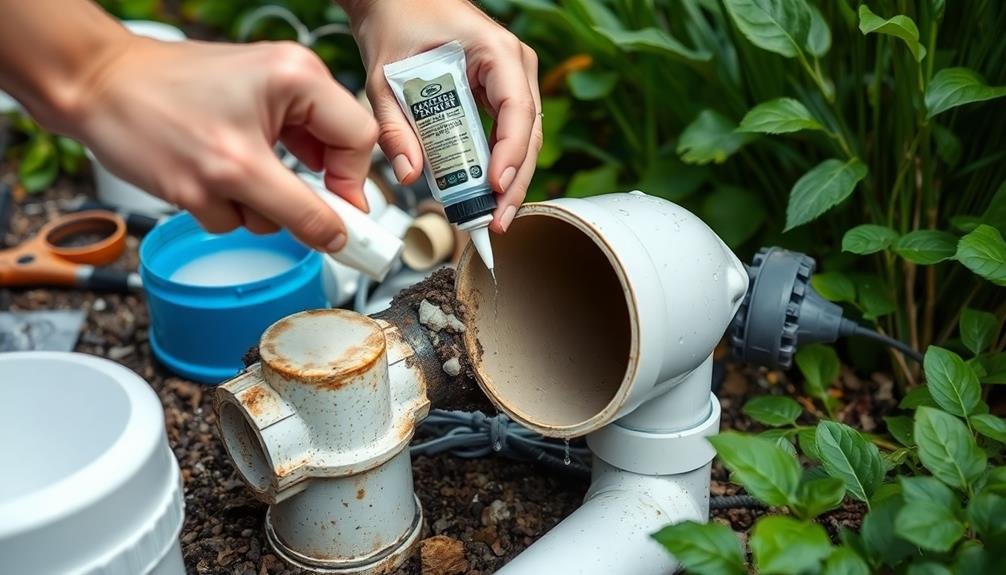
How can you guarantee your greywater system remains watertight? Regular inspections and prompt repairs are essential. Check for leaks and cracks in pipes, tanks, and connections at least once a month. When you spot an issue, address it immediately to prevent further damage and make certain your system's efficiency.
For small leaks in PVC pipes, you can often use pipe cement or epoxy designed for plumbing repairs. Larger cracks may require replacing the damaged section entirely. For concrete tanks, use hydraulic cement to seal cracks and prevent water seepage.
When repairing leaks and cracks, follow these steps:
- Shut off the water supply and drain the affected area.
- Clean and dry the damaged surface thoroughly.
- Apply the appropriate repair material according to manufacturer instructions.
Don't forget to check underground components, too. Look for wet spots or unusually lush vegetation in your yard, which may indicate a leak in buried pipes.
If you're unsure about the repair process or encounter a major leak, it's best to consult a professional plumber experienced in greywater systems to make certain proper repairs and system integrity.
Updating System Components
Technology and best practices for greywater systems are constantly evolving. To keep your system efficient and compliant with current standards, you'll need to periodically update its components. Start by evaluating your system's age and performance. If it's more than 5-7 years old or showing signs of inefficiency, it's time to contemplate upgrades.
Focus on key components like filters, pumps, and distribution systems. Replace old filters with newer, more efficient models that can remove smaller particles and reduce clogging. Upgrade to energy-efficient pumps that can handle your household's water flow while consuming less power.
Think about installing smart controllers that can optimize water distribution based on soil moisture levels and weather conditions.
Don't forget about piping and valves. Replace old PVC pipes with more durable materials like cross-linked polyethylene (PEX) or copper. Install backflow preventers and check valves to guarantee water flows in the right direction and doesn't contaminate your freshwater supply.
If you're using your greywater for irrigation, update your distribution system with pressure-compensating emitters for more uniform water distribution. These upgrades will improve your system's performance, longevity, and environmental impact.
Frequently Asked Questions
Can I Use Greywater for Watering My Vegetable Garden?
You can use greywater to water your vegetable garden, but you'll need to be cautious. It's best for fruit trees and ornamentals. For edible plants, avoid direct contact and use only water free from harsh chemicals.
How Much Money Can I Save by Installing a Greywater System?
You can save considerably on water bills by installing a greywater system. Your savings depend on factors like household size and water usage. You'll reduce your water consumption by 30-50%, potentially saving hundreds annually on utilities.
Are There Any Legal Restrictions on Using Greywater Systems in My Area?
You'll need to check your local regulations, as legal restrictions on greywater systems vary by area. Contact your city or county's building department or water authority to learn about specific requirements and permits for your location.
What Detergents Are Safe to Use With a Greywater System?
You'll want to use biodegradable, plant-friendly detergents for your greywater system. Look for products labeled "greywater safe" or those without sodium, boron, or chlorine bleach. Avoid phosphates and antibacterial soaps to protect your plants and soil.
Can I Connect My Kitchen Sink to My Greywater System?
You shouldn't connect your kitchen sink to your greywater system. It contains oils, fats, and food particles that can clog pipes and attract pests. Instead, focus on using bathroom sinks, showers, and laundry water for your greywater system.
In Summary
You've now got the tools to keep your greywater system running smoothly. Remember to stick to your maintenance schedule and address issues promptly. By following these steps, you'll extend your system's lifespan, improve its efficiency, and guarantee it's eco-friendly. Don't forget to stay updated on local regulations and new technologies. With proper care, your greywater system will continue to benefit your household and the environment for years to come.



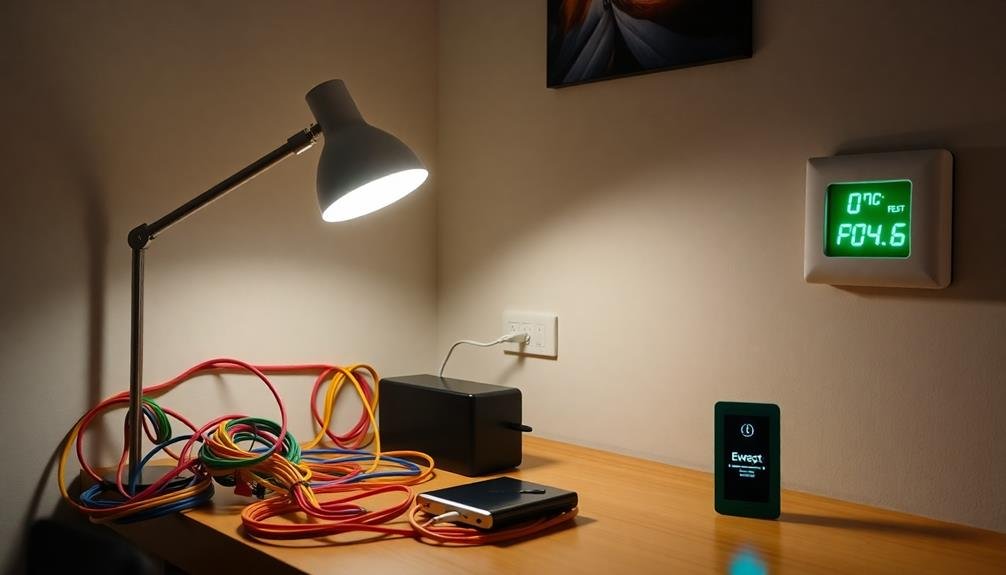
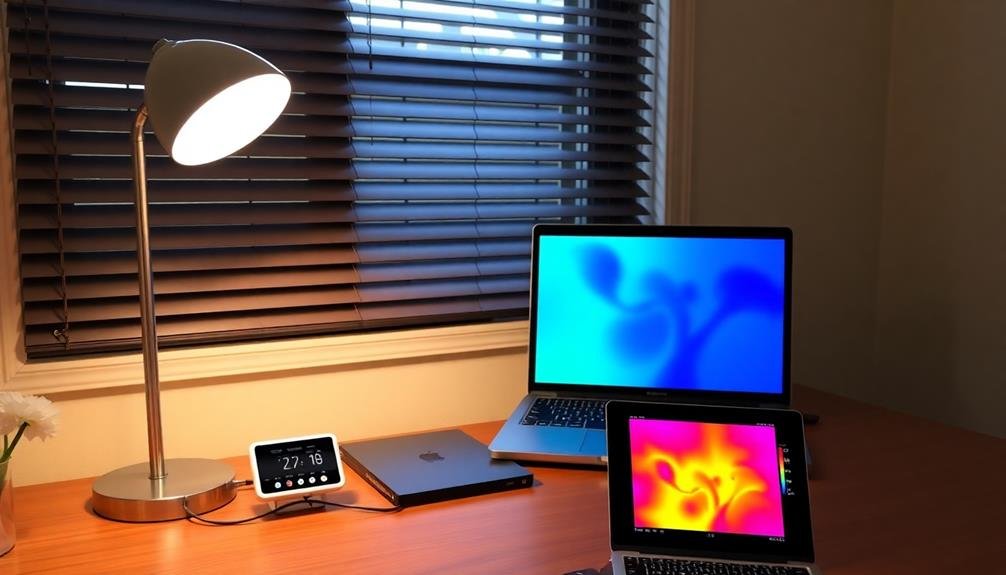
Leave a Reply